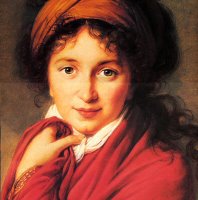 Coming back from the months away, I seem to be in a close orbit around Jim Putnam’s blog; but hey, there are worse orbits to be in, and I’ll boost clear as the old muscles get used to being used again.
Coming back from the months away, I seem to be in a close orbit around Jim Putnam’s blog; but hey, there are worse orbits to be in, and I’ll boost clear as the old muscles get used to being used again.
Jim comments, as part of a post on the theme of change, on a Domenichino sybil which has hit the sweet spot for him. He doesn’t specify exactly which of the sybils it is but from his description I’m fairly sure it’s the 1616/1617 Sibilla, though it could be the very similar Sibilla Cumana of 1610.
My interest here is the way such images reach across centuries to touch hearts, and the similarity between that reaching and the similar touch of faces in the here and now. Why does one face capture us, become the key that turns our personal lock, and not the sea of others?
Jim’s Sibyl does nothing for me; that doesn’t matter, all that matters is that she does for him. And I can see why she reaches him – the edge of her gravitational field tugs at me even though it fails, in the end, to capture me. Domenichino himself shows evidence of being captured by particular faces: the model who posed for the later 1622 version of Sibilla Cumana appears in other paintings which he did around the same time (as St Agnes, for instance).
When I was about twelve years old, while other boys were fantasising about Diana Dors, Marilyn Monroe, or Jayne Mansfield, I fell hopelessly in love with the Countess of Golovin, as painted almost two hundred years later by Elisabeth Louise Vigée-le-Brun. (That's her at the top left of this page: a detail from the painting. Click it for a larger view.) I had a lot of fun poked at me over this, and learned to keep it quiet from my friends; but the small poster which my parents obtained from somewhere or other stayed pinned to the inside of my wardrobe door or somewhere equally discrete (getting steadily more battered and frayed) until I finally lost it somewhere in my late teens or early twenties.
Vigée-le-Brun’s Golovin still hypnotises me now, forty years on, and with adult insight I can say why: it’s the vivacity of personality coming through, and especially the way it comes through those extraordinary eyes which look frankly out at you.
So is it just the eyes, then? Apparently not … I tried cropping out the eyes from my Golovin and all three candidates for Jim’s Sibilla, and laying them out together on the screen, and all of them became equally lifeless, leaving me equally untouched.
I went back to close cropped faces, all surroundings eliminated but the complete face of each still visible. Golovin’s magic was back with full force, and so was the perceptible almost pull of all three sybils. I studied the other details. I found that I don’t like the sybils’ mouths (too small, too red, too cupid’s bow) but Golovin’s is pleasing. Cropping down to just the mouths, though, all of them again left me equally indifferent.
So, it’s something in the totality of the way that particular components interact which produces this magnetism which draws Jim to the sybils and me to Golovin. I know that it is humour, intelligence, and eyes that draw me in real, living human beings (male and female, old and young; this is not sexual attraction I am talking about although it plays its part in that too); looking at Golovin, I find that the vivacity I mentioned contains both intelligence and humour. Actually, intelligence is not strictly the word I mean … “interestedness” is closer: a quality of inquisitiveness, of wanting to know about the world and all that is in it.
So … where has all this gotten me? Nowhere in particular, really, I suppose; but I enjoyed the journey. Sorry if you enjoyed it less – but then, if that’s the case, you probably abandoned ship some time ago...
(Later addition: Jim takes this further in a post under the same title.)
1 comment:
I have to admit, having looked through Clare's pick of highlights from Figuration Féminine, that I like the look of Judith Leyster. She's less conventionally attractive, but she looks confident, competent, and great fun.
Post a Comment